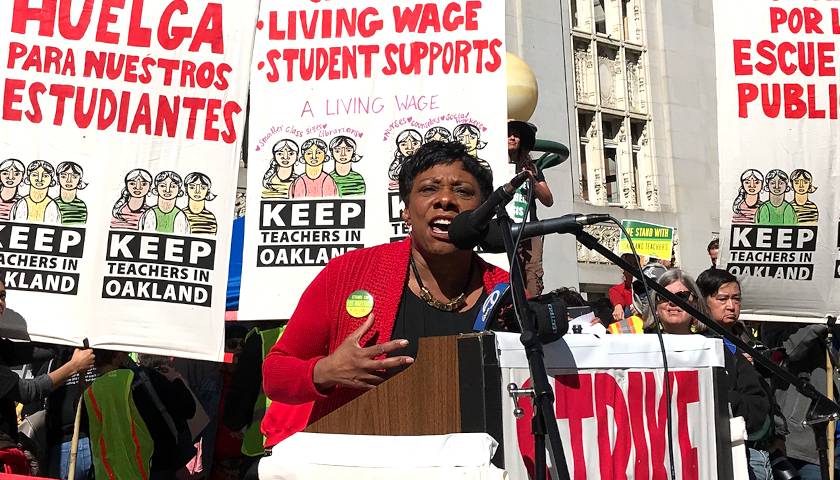by Todd Carney
Before the 2024 election, six swing states will have supreme court elections that could flip which party controls the state’s supreme court.
Rulings by state supreme courts on redistricting maps have led Cook Political to revise their projections on who redistricting favors, from favoring Republicans, to being a wash. This didn’t happen by Democrats’ good fortune. Former Attorney General Eric Holder and other Democrats have targeted state supreme court races over the last decade and are continuing to do so. In response, the Republican State Leadership Committee declared in a memorandum: “Democrats’ past spending on state court races paying off in redistricting fight.” Republicans believe they have a plan to fight back in future court races, but this round of redistricting will likely be done before any of those races are decided.
State courts are highly relevant to the overall administration of elections, from reviewing voter ID requirements, drop box allowances, due dates for mail-in ballots, or other factors. Though it comes as a surprise to many, state supreme courts have at least as much power as federal courts when hearing election cases. Consider that the U.S. Supreme Court has shown a reluctance to intervene on election cases, likely due to concerns over the Court looking too partisan, and you quickly realize state courts could be the final arbiters on election rules that govern who becomes the next president. Let’s look at six swing states and analyze the dynamics of their supreme courts.
Minnesota
Currently, the Minnesota Supreme Court is 5-2 in terms of Democrat-to-Republican appointments. Two justices are up for re-election, Gordon Moore and Natalie Hudson. A Democrat governor appointed both of these justices, meaning that if they lose re-election to two candidates with a Republican affiliation, the Minnesota Supreme Court would flip to 4-3 in favor of Republicans. The races are officially non-partisan, but parties do endorse candidates.
This court has not attracted a ton of election controversy. In 2020, some in the GOP challenged the presidential election results, but the supreme court unanimously rejected it. In October 2020, the Minnesota Supreme Court received a lawsuit from the GOP challenging the Minnesota Secretary of State’s decision to count late-arriving mail-in ballots. But the 8th Circuit ruled in favor of the GOP in a similar case, so it made the decision moot.
Wisconsin
Wisconsin has an officially non-partisan supreme court. However, all of the justices have a general ideological affiliation, so experts peg the court as favoring conservatives by a margin of 4-3, with one conservative justice serving as a bit of a swing vote, just as former U.S. Supreme Court Justice Anthony Kennedy did in his final years on the bench. The only election before 2024 for this court will occur in April 2023. Conservative Justice Patience D. Roggensack is not running for re-election, but her daughter, who is a Milwaukee circuit court judge, will run to replace her. The ideological flavor of the court could hinge on this election.
In 2020, the Wisconsin Supreme Court ruled 4-3 against throwing out Biden’s win. Justice Hagedorn ruled with the liberals in this case. Interestingly, the court has had mixed rulings on ballot drop boxes, with the outcome all dependent on Hagedorn. So, if a conservative wins in 2023, it will likely come down to Hagedorn; if a liberal wins in 2023, then the liberal outcome will likely prevail in these cases.
Michigan
Currently, the Michigan Supreme Court has a 4-3 Democrat majority. The Democrats took the majority after the 2020 election when they picked up a seat. In 2022, two justices will face election, one Republican and one Democrat. So, Democrats could increase their majority, the status quo could remain, or Republicans could take the majority. Interestingly, parties nominate candidates and then they all run in a general election without identifying party affiliation, where the top candidate(s) prevail. So, if there’s two seats up for election, the top two get elected.
Leading up to the 2020 election, the main election lawsuit concerned whether Michigan could count ballots that came in after election day. The supreme court ruled on partisan lines that Michigan could not count the ballots. After the 2020 election, the lame duck Republican majority ruled on some cases related to the 2020 election. By a vote of 6-1, the Michigan Supreme Court ruled against hearing a case whether the secretary of state had authority to send out absentee ballots to people who had not requested them. The Michigan Supreme Court declined to do so on the basis that the 2020 election had occurred, so the issue was moot. Similarly, the Michigan Supreme Court ruled against a lawsuit seeking to stop the certification of ballots in Wayne County because the certification had occurred, so the case was moot.
Interestingly, there was one case in the aftermath of the 2020 election that was close. It was a case brought by two Trump voters, who sought an audit of the 2020 election due to issues with voter fraud. The audit would have prevented Michigan from certifying the election. The Michigan Supreme Court ruled 4-3 against the plaintiffs, with Republican justice Elizabeth Clement voting with the Democrats. Clement remains on the bench.
The new Democratic majority has some interesting rulings. First, in January 2022, the court struck down a law that added more requirements to petitioning for a ballot initiative. In that case, Clement voted with the Republicans, but another Republican justice, Brian Zahra, voted in part with the Democratic majority. In February, the Michigan Supreme Court also dismissed a lawsuit raised by civil rights groups that challenged the redistricting commission’s maps. The plaintiffs then brought a suit to have the Michigan Supreme Court reconsider their own ruling, and the same split ruled against reconsidering the lawsuit. It is possible that the decision broke down more among procedural disagreements, but this leaves a lot of mystery as to how the court could rule, regardless of the 2022 Michigan Supreme Court election results.
Ohio
The Ohio Supreme Court has made a lot of noise this cycle due to rulings on redistricting, repeatedly deciding against Republican plans for redistricting despite a Republican majority. The reason for this is that the current Republican chief justice, Maureen O’Connor, is a swing vote a bit in the mold of Chief Justice John Roberts. Interestingly, O’Connor is retiring, and two other Republicans are also up for reelection in 2022. The Democrats are not up until 2024 or later. So, with that in mind, the ideological flavor of the Ohio Supreme Court weighs in the balance.
One thing Republicans have done in an effort to sweep all three races in 2022 is mandate that party affiliation is listed next to nominees in the 2022 election. In prior years, parties would nominate justices, but then in the general election, they would not have party affiliation next to their names on the ballot.
Pennsylvania
Currently, the Pennsylvania Supreme Court has a 5-2 Democrat majority. Chief Justice Max Baer is going to be forced to retire at the end of 2022, at which point the governor will appoint his replacement. Regardless, there will be an election within 10 months of that appointment. That is the only Pennsylvania Supreme Court election before 2024. Though it may seem the balance of power cannot change regardless, several of the contentious decisions have been 4-3, with Baer always siding with the Democrats, showing some possibility for a power change.
The Democrat majority on the court has flexed its partisan muscles since 2018, when the court threw out the redistricting map passed in 2010 by Republicans, and put in place a map favorable to Democrats. Given Democrats’ slim majority in the U.S. House, this ruling is partially responsible for Democrats still having control of the U.S. House. Then, in 2020, in the lead up to the election, the Pennsylvania Supreme Court ruled to extend when absentee ballots needed to be mailed in to be counted, to allow additional drop boxes, and kicked the Green Party candidate off ballots. In the aftermath of the 2020 election, the Pennsylvania Supreme Court overwhelmingly rejected a lawsuit trying to throw out absentee ballots.
In the last year, the court has rejected a challenge to the state’s mail-in voting law, and took over this round of redistricting and put in place a map that favored Democrats. It is worth noting that this ruling was 4-3, so with one more Republican vote, the Republican map could have prevailed.
North Carolina
The North Carolina Supreme Court has a 4-3 Democrat majority. Two of the Democrat justices will have to run for re-election in 2022, and those are the only North Carolina Supreme Court justices who will face re-election before 2024. As a result, the court will either remain the same as it is now, it will have a narrow Republican majority, or a solid Republican majority.
The court has delivered rulings that favor Democrats. Interestingly, in the lead up to 2020, there were not really any challenges raised by Republicans in the North Carolina court system. Instead, they went through federal court. Perhaps Republicans felt it would be a lost cause due to the partisan make-up of the court. Additionally, North Carolina, like Pennsylvania, had a mid-decade redistricting, which came through federal court because it was a racial gerrymandering case. However, a later partisan redistricting challenge in 2019 did come through the North Carolina court system, but was adjudicated at a three-judge panel.
The partisan make-up of North Carolina’s supreme court has grabbed headlines for its decision to strike down Republicans’ redistricting maps, a vote that came down along party lines. As noted, none of the presidential election challenges occurred through the North Carolina court system, but if Republicans take the majority of the court, it is easy to imagine them pursuing future challenges in the state system, given their bad luck with federal court challenges in 2020.
Conclusion
With all of this in mind, a cynic could say Republican justices will favor whatever helps Republicans, and Democrat justices will do the same for Democrats. That’s true, but there are profound, technical disagreements over what legally enshrines “the right to vote” and how much a court can change voting laws. Both sides care about issues like voter ID, early voting, and drop boxes because they believe these policies could impact election outcomes. Whatever your policy preferences, these supreme court races matter—if either party dominates, it will give them an advantage in 2024.
– – –
Todd Carney is a lawyer and frequent contributor to RealClearPolitics. He earned a juris doctorate from Harvard Law School. The views in this piece are his alone and do not reflect the views of his employer.
Photo “Minneapolis State Supreme Court” by Jonathunder. CC BY-SA 3.0.




